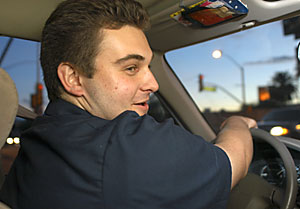 |
|
FILE PHOTO
|
Former SafeRide director Josh Wright drives one of the SafeRide vehicles to pick up a student in September 2003.
|
|
|
By Jesse Lewis
Arizona Daily Wildcat
Friday, October 22, 2004
Print this
Keeping safe on campus is a major concern for students and their parents, and the UA has a variety of safety programs and outlets to keep students out of harm's way.
SafeRide car escort service, emergency blue lights, the OASIS Center for sexual assault victims and the University of Arizona Police Department are all available to promote the safety of the campus community.
UAPD is the UA's campus police department and the officers patrol campus 24 hours a day by car or bike to ensure the safety of campus residents, commuters, visitors, parents and staff.
Sgt. Eugene Mejia, UAPD spokesman, said adjusting to life away from home can be difficult, but it is important to know there are people here looking out for the safety of this campus.
UAPD can't make students stay out of trouble, but it can inform them about the consequences, Mejia said.
"We have to educate them and hope they were paying attention," Mejia said.
Numbers to know
UAPD: 520-621-UAPD
SafeRide: 520-621-SAFE
The Oasis Center: 520-626-2051
|
Mejia said the campus is what students make of it; it can be as safe as students want it to be. If a student suspects something out of the ordinary or sees someone suspicious, he or she should call the police. It may help catch a criminal in the act or prevent a crime from happening, Mejia said.
"Even though we are paid to do what we do, without (student) participation, it is much more difficult to do it alone," Mejia said.
SafeRide, a free shuttle service sponsored by the Associated Students of the University of Arizona, is available to students Sunday through Thursday from 6:30 p.m. to 1 a.m.
The service runs from East Grant Road to East Broadway Boulevard and from North Fourth Avenue to North Tucson Boulevard.
The service offers five four-passenger cars and a golf cart that run through campus every school night.
Students can call the service at 621-SAFE and a car will respond as soon as it is available.
Joshua Wright, SafeRide director, said the service always receives a lot of ride requests.
The service served 36,000 students last year and more than 10,000 students so far this year, Wright said.
"It's a very, very popular student safety program and we serve a wide variety of people including graduate students and staff," Wright said.
SafeRide recently expanded its boundaries to better serve the campus by transporting students to the Pima Community College Downtown Campus, 1255 N. Stone Ave.
"Use your head: it's convenient to say 'I'm not that far, I'll just walk,' but things can happen. Chances are you'll be fine, but why chance it?" Wright said.
Wright said SafeRide is not a party shuttle and no one will be dropped off or picked up at a location that is serving alcohol.
There are 185 blue emergency light stations on campus equipped with an alert system that dials directly to UAPD dispatch.
When a person has an emergency, they push the red button. The blue strobe light on top flashes and police respond.
"You are fairly close to a blue light pole anywhere you are on campus," said Herb Wagner, assistant director of risk management and safety.
The first 16 lights were installed on campus in the 1980s and as new buildings open, lights are placed in the area.
UAPD usually receives calls for medical emergencies or people who have been injured or are having a problem on campus, Wagner said.
Residence halls have a calling box at their front doors to call hall residents or the front desk. Emergency calls can be made with those phones, also.
The older phones like those in Second Street Garage and near McKale Center have a handset instead of an alert button, which is not compliant with the Americans with Disabilities Act. Those phone will be replaced within the next year, Wagner said.
The OASIS Program for sexual assault and relationship violence is available for students to find counseling and learn about how to stay safe in a relationship.
OASIS offers women-only self-defense courses to teach techniques in prevention, risk reduction, avoidance and hands-on self-defense methods, said Michelle Dorsey, a psychologist at OASIS.
All self-defense courses are offered in the Campus Health Building in the Highland Commons area. One-day courses are $20 and four-day courses are $40.
The center also gives presentations in classes and at orientation about rape and violence prevention methods.
